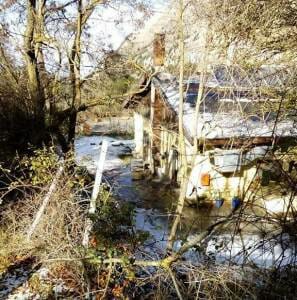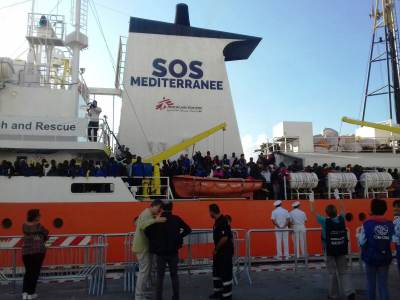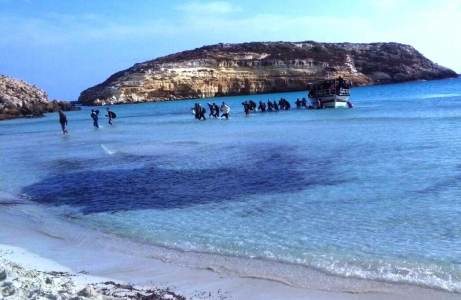THE REPATRIATION OF THOSE WHO HAVE NOT BEEN REPATRIATED
Lists of
the missing and the saved Tunisians in the waiting room of their Consulate.
Four pieces
of paper hanging on the wall- this is all that remains in the Tunisian Consulate
in Rome of the
Tunisian migrants who went missing between February and March. Are they lost at
sea? There is no evidence to show they ever arrived in Italy. Is it possible they are in France?
In Italy they haven’t been
registered so they may have passed directly into Europe.
Could they be somewhere else and not passed on information of their
whereabouts? The families have sent the names of the people they have been
looking for since April. No official date of anyone being found, or for that
matter even looked for, has been added to the A4 sheets on that wall.
During
those two months of continual arrivals, the dates on the lists are the main
thing that varies; the rest is the same story of people who are untraceable.
The list is quite old and on those dark walls of the Consulate, it hasn’t been
updated. You would think looking at those four pages that there’s a hope that
at least someone may have phoned to say they had arrived. But good news
has no place on those walls.
They are not the only four
pages hanging on the wall. Just beneath them there are others containing many
more names. These are the lists of the Tunisians which are present in all of
the CIEs (Centres for Identification and Expulsion) in Italy. The list was updated in
September 2011, faxes were sent from Trapani to Turin passing through Bari
and Bologna, and Rome’s Ponte Galeria. Maybe it was updated in
September, before the fire at the centre in Lampedusa which led to its closure,
because after that date from the boat-prisons where the Tunisians were kept for
a couple of days it wasn’t possible to send a fax. And for those on the CIE
boats the next step was a direct trip to the airport of Carthage.
I look through the names of the people detained in every corner of our country.
I know that Sayfuluddine ended up in Via Corelli in Milan where he made a call asking to be
released, asking for a lawyer, speaking about the easy beatings which the more
outspoken refugees of the centre would receive. “Marta, this is not a
centre,” which is the term I usually use to refer to such places,
“this is a prison in all senses of the word.” But he didn’t stay
there for even a month. On 5th October, he was sent back to his country. But these
lists don’t mention such details.
I continue to look through the lists and come across a Muhammad Amin who wanted
me to believe that he was under 18. I recognise his surname and date of birth,
23/01/91- his real date of birth. Anyone making a false declaration, such as
claiming to be under 18 would have been sent directly to Milo (the CIE in Trapani) with the adults. To
be sent back home.
But in the Consulate’s waiting
room, where the names of the Tunisians to whom no one knows what happened are
hanging on the wall, those who stayed meet again. They seemed to have narrowly
escaped death or been through a living nightmare, some of them actually have,
recently.
Mounia came out of the CIE Ponte Galleria 20 days ago after four months inside.
After a period of four months, Article 18 allows her to legally stay in Italy for the following 6 months in sheltered
accommodation with other women like herself who have been torn from the peace
and quiet of their normal lives after getting divorced in Tunisia.
“You are free,” they said to her.
“What?”
After four months she didn’t know the meaning of this word.
“What
does ‘free’ mean?”
You can go,
you are free, get out of here.
In the waiting room Mounia bumps into Atraf: they hadn’t seen in each other
since they were inside Ponte Galleria,
when she lent him her mobile to make a call to Tunisia. A phone call to his mother
in Mounastir to ask her to send his identity card in order to legally prove
that he really was under 18. He arrived
in Linosa during the chaotic days following the fire in Lampedusa when there
was no organisation monitoring the arrival of the boats, nobody believed him
when he was asked how old he was. Even in the hospital at Agrigento it was impossible to legally prove
his age. He does seem too tall and well-built to be under 18. This is exactly
how young teenagers end up locked up in CIE centres.
Thanks to
the phone call made on Mounia’s mobile, a fax arrived from Atraf’s mother: I
really am 17 years old and I left Tunisia after the death of my
father. Now I am free.
There is no end, however, to the Tunisians who are being sent back to their
country. Ibrahim, who is also known as “5th April”- the date when he
arrived and also the date of an agreement between Tunis
and Rome, stating that after that day Tunisians
arriving in Italy
would no longer be granted the permit of stay on humanitarian grounds. Those
arriving on 5th April were saved by the skin of their teeth.
There is
another young man who was also under 18 when he arrived and didn’t go through
the ‘prison’ experience. He is one of the many who experienced the long boat
journeys in April from Lampedusa to who knows where. Now Shihab lives in
Frosinone, from Sidi bu Sid to Frosinine. He is now 18 years old, but hopes
that the fact that he has won a national boxing competition will gain him
support from the local community and enable him to renew his permit of stay and
allow him to remain in Italy.
The young men and women don’t ask for anything else other than the permission
to stay. In 2011, the issue was high profile, when the revolution left them
with no choice but to leave their country and also when the centre in Lampedusa
burnt down. Now they seem to have all disappeared.
Some of them really have, some live in fear because their immigrant visa is
about to run out and might not be renewed, some have bought immigrant visas,
some have been sent back home- a real possibility as no further emergency
agreement has been made allowing them to remain on Italian soil.
The lists
in the Consulate are getting dusty and the stories are getting worse: the
people are lost. Or they have passed from the reception centres to the streets
to houses they have now left: but their lives and these traces of Italy on the distant shores of the Mediterranean are very much alive, even if until now they
haven’t been saved.
Marta Bellingreri



